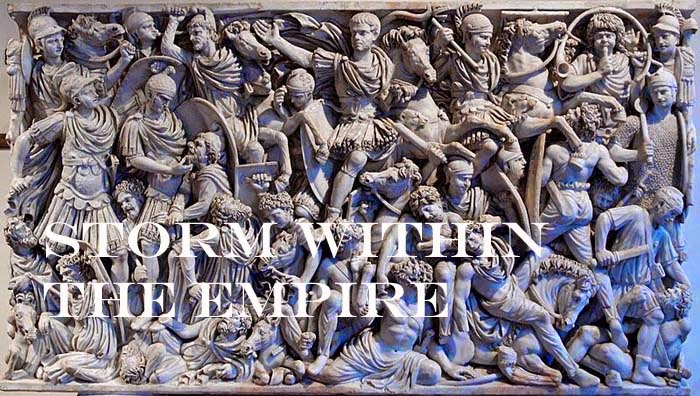The Roman army were deployed for battle, both flanks and rear were protected by woods. Facing Rome, the Marcomanni deployment was split by a marsh, but as the battle progressed, this would prove no obstacle.
Skirting the marsh, the Marcomanni cavalry resumed its support role, protecting the left flank of the infantry. Holding its position, Rome re positioned its auxilia infantry to extended the line revealing the legionnaires in reserve.
The Marcomanni left engaged the Roman legion and artillery, but were easily repulsed. On the right, the Marcomanni were successfully making headway.
Seeing the success achieved (3-1), the Marcomanni renewed their attack against the Roman left flank.
Sensing the Marcomanni assault faltering, Rome assumed control of the battle. Roman light horse, circuiting the wood, struck the Marcomanni line in the rear while it was engaged with the legion to its front. The artillery added further casualties forcing the Marcomanni to leave the field. Rome was victorious, 5 – 3.
Switching
deployment zones, the Marcomanni packed its centre with dense columns of
infantry flanked by warriors trained in the Roman fashion (4Bd). The legion in
standard battle formation, legion in centre with flanks protected by auxiliary
infantry and artillery, held all its mounted troops in a second line as a
reserve.
The clash of arms came quickly and despite some loss, the Marcomanni were repulsed. Both sides attempted flanking manœuvers, but the Marcomanni were easily foiled by archers ensconced in the marsh. Unhindered, Roman equites found themselves viewing the rear of the Marcomanni.
The expected barbarian breakthrough did not materialise prompting their general to recall the cavalry add their weight to the centre. Too late, a resurging Rome rolled up the Marcomanni left and centre to rout to send the barbarians off the field. Rome, 5 – 2.
Observations.
Striking
the enemy’s rear proved fortuitous in both games. Despite a few poor pip
scores, the LH were moved closer toward their final destination.
The
artillery proved their value eliminating an enemy in both tests. Other times,
the barbarian line buckled as troops recoiled from its effect.
One blunder
was avoided when Roman cavalry held in reserve were caught in the enemy’s
threat zone. These were later repositioned further back, but still in charge
reach.
Early Imperial Roman
1 x General
(Cv), 1 x equites (Cv), 4 x legionnaires (4Bd), 3 x auxilia infantry (4Ax), 1 x
archers (Ps), 1 x light horse (LH), 1 x artillery (Art).
Marcomanni
1 x General
(Cv), 2 x cavalry (Cv), 6 x warriors (4Wb), 2 x warriors trained in Roman
fashion (4Bd), 1 x skirmishers (Ps).




























